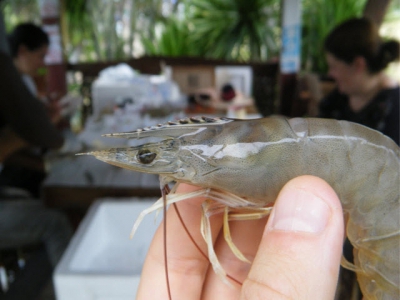Aquatic health group designated as reference lab

OIE designates U.K.'s Cefas as Collaborating Center for Emerging Aquatic Animal Disease, a global reference laboratory.
Cefas scientists studying diseased shrimp during an emergency harvest in Thailand
The U.K.’s science expertise and international leadership in identifying and managing new diseases that affect the farming of seafood, or aquaculture, has been recognized by the World Organization for Animal Health (OIE).
The Center for Environment, Fisheries & Aquatic Science (Cefas) has been designated by OIE as the Collaborating Center for Emerging Aquatic Animal Disease (EAAD), building on Cefas’ expertise in disease detection and diagnosis and its strong international partnerships with other expert centers, the announcement from the U.K. government said
The center will play a central role in achieving effective aquatic animal disease control in developing countries where aquaculture is one of the fastest-growing food sectors and a critical component of food and income for those nations.
Cefas will support the goal of securing sustainable production from this sector in coming decades, with particular focus on strengthening global food security and preventing devastating economic and social impacts associated with disease, resulting in multibillion-dollar losses worldwide, the announcement said.
“With demand for farmed fish set to grow globally over the coming decades, it is more important than ever that we combat the threat of disease," U.K. biosecurity minister Lord John Gardiner of Kimble said. “By working together, we can bolster food security, protect public and animal health and ensure sustainable production. I am proud to see the U.K. at the very heart of this united effort, and the World Organization for Animal Health’s recognition of Cefas as a collaborating center is an excellent example of Britain’s world-leading role in science.”
Global aquaculture production has increased rapidly in recent decades to meet growing consumer demand for seafood, with aquaculture now exceeding wild-capture fisheries as a source of aquatic animal protein and estimated to double to meet global needs by 2050.
According to the announcement, a network of associate laboratories based in major aquaculture-producing regions (China, Thailand, India, South Africa, North America and South America) as well as the European reference laboratories for fish and crustacean diseases — DTU in Denmark — and for mollusk diseases — Ifremer in France — will partner with Cefas to focus on emerging disease issues.
A key objective of the network is to harmonize and exchange information and expertise to improve emerging disease surveillance globally and to mitigate the negative effects of disease in this rapidly expanding sector.
Cefas head Stephen Feist said, “The international consortia of labs will provide a unique mechanism to tackle emerging disease threats in aquaculture and fisheries globally, ensuring rapid detection, sharing of knowledge and expertise in mitigating their effects. Cefas’ leading capability in pathogen identification, diagnostics, pathology and disease management will ensure that new threats are rapidly identified and notified to appropriate authorities to assist control.”
The collaborating center draws upon the expertise of some 90 Cefas scientists specializing in fish, mollusk and crustacean health based at the center's Weymouth Laboratory and is funded by the U.K. Department of the Environment, Food & Rural Affairs. The EAAD center fits within the International Center of Excellence for Aquatic Animal Health at Cefas.
Có thể bạn quan tâm
 CPTPP has a positive impact on Vietnam's shrimp exports
CPTPP has a positive impact on Vietnam's shrimp exports Shrimp exports in the first months of 2019 decreased compared to the same period last year took effect from the beginning of 2019 and has been impacting Vietnam
 Self-farming aquaculture? It’s closer than you think
Self-farming aquaculture? It’s closer than you think With remote robots set to carry out more and more routine tasks and facial-recognition software being applied to salmon, automation is already making waves
 Opportunities for tra fish to enter Chinese market
Opportunities for tra fish to enter Chinese market As one of the popular products in the Chinese market, tra fish (pangasius) have huge potential for being exported to the neighbouring country in 2019